Thomas Peake died on September 21st following a fall while hiking in the Grand Canyon. The following evening, bits flew raced around the interent as word spread of this horrible news. I first heard from Brendan Digel, who relayed Dara O’Niel’s Facebook dispatches about the search for him Monday night and Tuesday morning. Shortly thereafter Jon Kincaid sent me brief word that Thomas had passed, and mentioned a Facebook page with more info. I talked to Allan Ross in New York and he sent me the link to the Thomas Peake Memoriam Page on Facebook. The National Park Service made a press release. Check out these sobering descriptions of the Lava Falls Route that Thomas was attempting. The next morning, the world continued to wake up to this sad news. Dave Slusher had a nice post, in which he linked to the Facebook image gallery.
—————————
Thomas is one of the original Great People on this planet.
Many people knew Thomas from his involvement at WREK. In the mid-80’s Arthur Davis led WREK in a determined shift to more adventurous programming. Thomas came on board in the late 80’s and continued what Arthur had started. Through a variety of official roles, Thomas was really our philosopher king for a few years, and his energy and enthusiasm for the programming and the radio station was infectious. There are so many great little things that happened during his tenure — the WREKology “zine” program guide, shepherding of new shows and show hosts, fundraiser concerts by nationally known bands … There was a powerful DIY ethic in Thomas and it really came out beautifully during his tenure at WREK — both from him and as a result from everyone around him.
Here’s an opinion piece that Thomas wrote in the early 90’s: http://www.cyberbuzz.gatech.edu/wrek/opinions/opinion1.html
To work at WREK for any appreciable amount of time is to discover that the world of music is far more vast than you ever imagined. Another staffer of the same period, Markus DeShon, came up with the concept that Music Is Sacred, in that music (real music) fundamentally represents deeply personal human expression and should be revered appropriately. Well, not the stuff on commercial radio, that exists just to separate fools from their money! As a lot of us did, Thomas dove into WREK and discovered a huge cultural cornucopia, including music well beyond our own shores and certainly beyond rock.
Another thing that Thomas did was put out feelers to the Atlanta music community, pulling it closer to WREK, and suckering a lot of the musical talent in town into helping do WREK shows or otherwise making WREK even better. It really can’t be overstated how integral WREK was to the Atlanta music scene in the 80’s and early 90’s, and a lot of that was due to Thomas and his positive energy.
Thomas was incredibly productive. I have deep respect for people whose hearts and minds are in the right place but also manage to Get Things Done. There is so much rhetoric, especially now that the internet has given so many of us a voice, and there seems to be little action to go with it. My years at WREK taught me the DIY ethic, and Thomas was the epitome of that, because not only did it make things happen, but he did it well. Lots of people have their heads screwed on right but can’t get their ASS in gear. Thomas’ ass was moving, constantly. And always with that goofy happy style of his.
I would like to ask his parents this: how did you do that? How did you raise a young man to be that smart, that engaged in the world, that overwhelmingly positive and warm to everyone he met? It’s just so completely remarkable. For many, to be politically and culturally aware these days is frankly to be depressed. Because there is so much evil and wrong around us, it’s hard to see the joy and wonder sometimes. But Thomas was as politically and culturally alive as any of us, and he was completely happy.
Here are some great quotes about Thomas from the last few days:
Ben Davis on the Facebook page: “I learned [from Thomas] that it was very punk rock to be friendly to people.”
Dara O’Neil quoted in the AJC article: “There was definitely something wrong with you if you didn’t like Thomas.”
Jon Kincaid in a short tribute during his Personality Crisis show on WREK: “Thomas always had a smile on his face, and after you met him, you always left with a smile on yours.” (stream link, tribute starts 5:15 into the third segment)
—————————————————
Probably half of the people who know Thomas know him through his tenure at WREK as a Georgia Tech student. He was one of a handful of people (I would argue two, with Arthur Davis) who really elevated WREK into the awesomenews stratosphere. During that time, Thomas produced countless radio shows, from his early weekly shows on punk rock early in his career, to the occasional Sunday Specials in which he would focus on a particular artist or genre.
A lot of those radio shows got taped by you Thomas fans out there, and you probably still have them. I want you to help us share them with the world.
Dave Slusher and I have created The Thomas Peake Podcast, found at www.PeakeCast.org. We will take everything we can find, digitize the audio into MP3 form, and make it available on the internet as a podcast. You can subscribe to the podcast, or download and listen on your computer, or download and burn your own CDs.
We already have the first show up. The one thing we could dig up right away was Thomas’ appearance on WREK just 5 years ago. In 2004, WREK moved from its old Coliseum studios to new digs in the center of Georgia Tech campus. To celebrate the 27 years that WREK had been at the old location, and give alumni one last chance to see the joint, I put together “alumni weekend” at WREK, where we took over the station and I invited past WREK staff to come in and spin records. Thomas had a one hour segment … and I totally knew he would play the Colorblind James Experience! Go to www.peakecast.org to hear it and subscribe.
That’s just a sample of what we hope to provide in the PeakeCast. But we need your help. If you know that you taped some of Thomas’ radio shows, GO FIND THOSE RECORDINGS NOW PLEASE. Go to www.peakecast.org and follow the instructions for submitting them to us. Dave and I will be collecting them and will then take care of digitizing and relaying all this musical goodness out to everyone else in the Thomas-o-sphere.
We realize that Thomas himself probably had the best collection of these tapes, but we’re certainly not going to bother Dena and family just yet. However, if Dena or any of Thomas’ family are reading this, know that we are ready to receive whatever you find when you are ready.
Thanks for reading, and stay righteous.
————————————————————–
Update Oct 2010: it’s been a year now. The PeakeCast has published eight episodes and we have lots more to come. This weekend we will remember Thomas with a day of hard work on the Beltline, improving a segment that starts just north of Memorial Drive. We miss him.

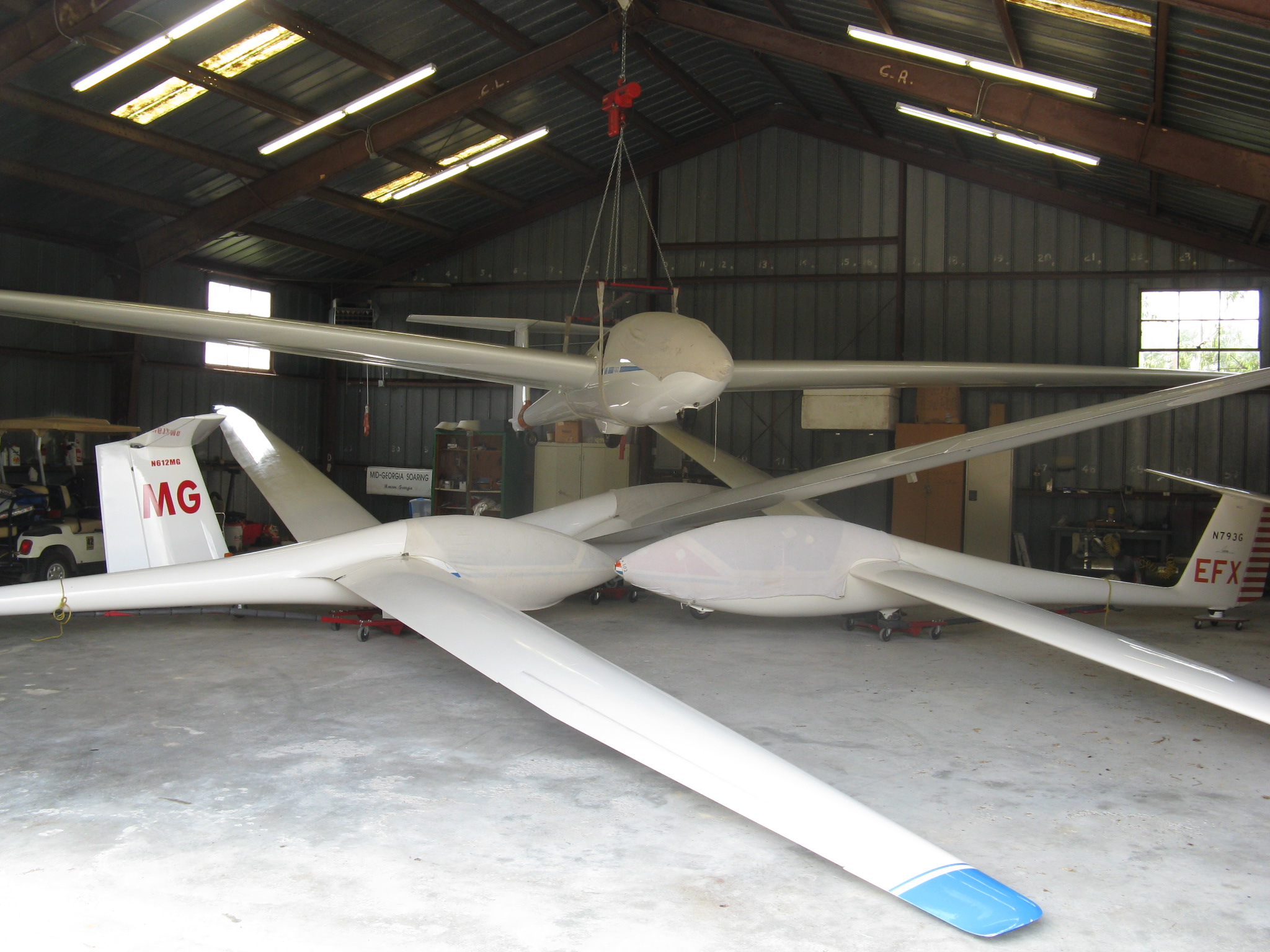 The club has a small hanger near the airstrip with the four communal aircraft jammed in there. It was fun watching them slowly untangle the delicate knot of 4 gliders that they’d managed to fit inside. Two of them are single-seat models, and two are tandem models used for “discovery” flights like the one I was to take.
The club has a small hanger near the airstrip with the four communal aircraft jammed in there. It was fun watching them slowly untangle the delicate knot of 4 gliders that they’d managed to fit inside. Two of them are single-seat models, and two are tandem models used for “discovery” flights like the one I was to take.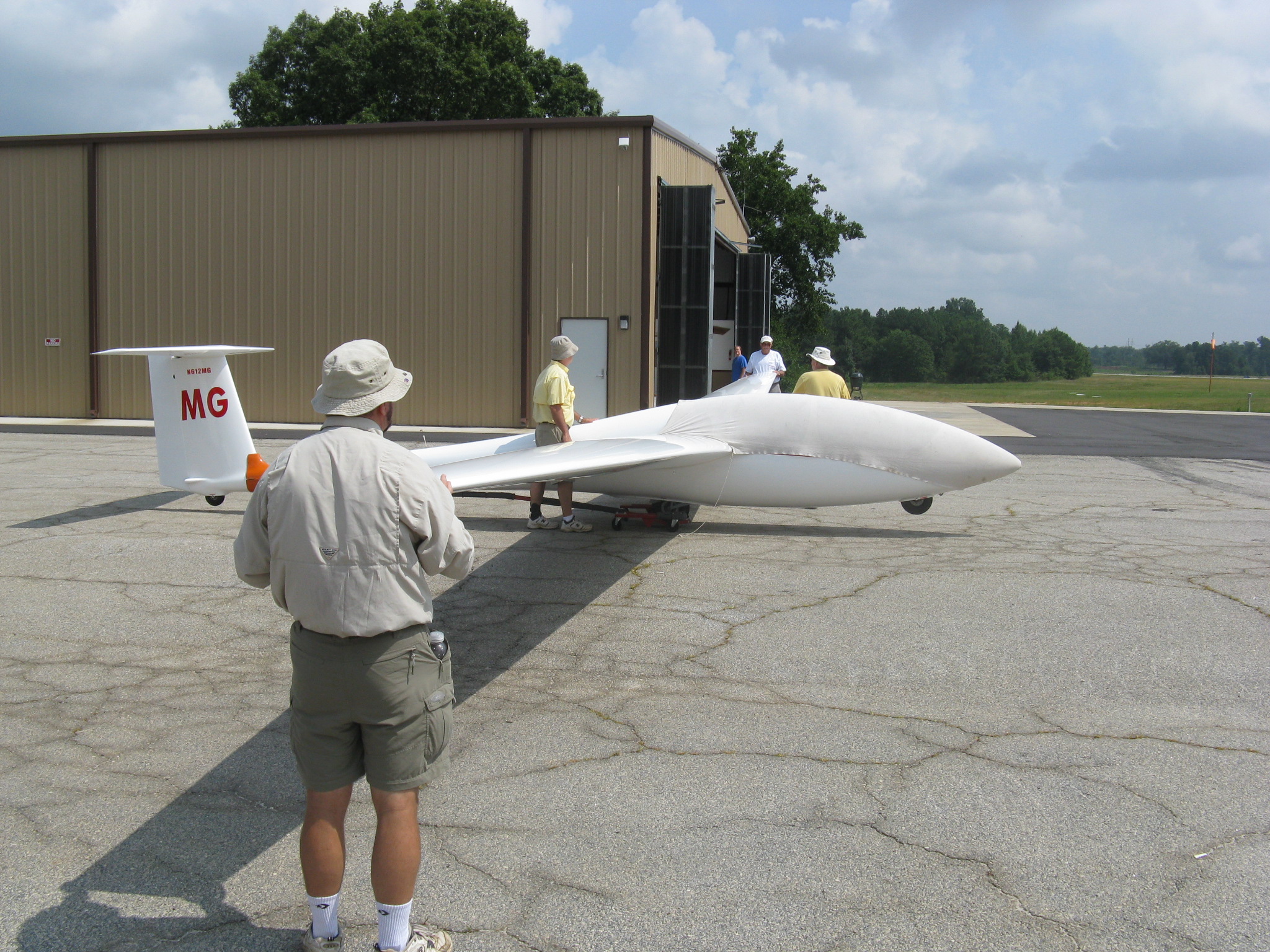 these photos, these gliders are light enough to be moved around by a couple of guys. After some basic checkout of the controls and flight surfaces, each glider got hooked up to a
these photos, these gliders are light enough to be moved around by a couple of guys. After some basic checkout of the controls and flight surfaces, each glider got hooked up to a  tow vehicle (e.g. golf cart) and the long walk out to the end of the airstrip began.
tow vehicle (e.g. golf cart) and the long walk out to the end of the airstrip began.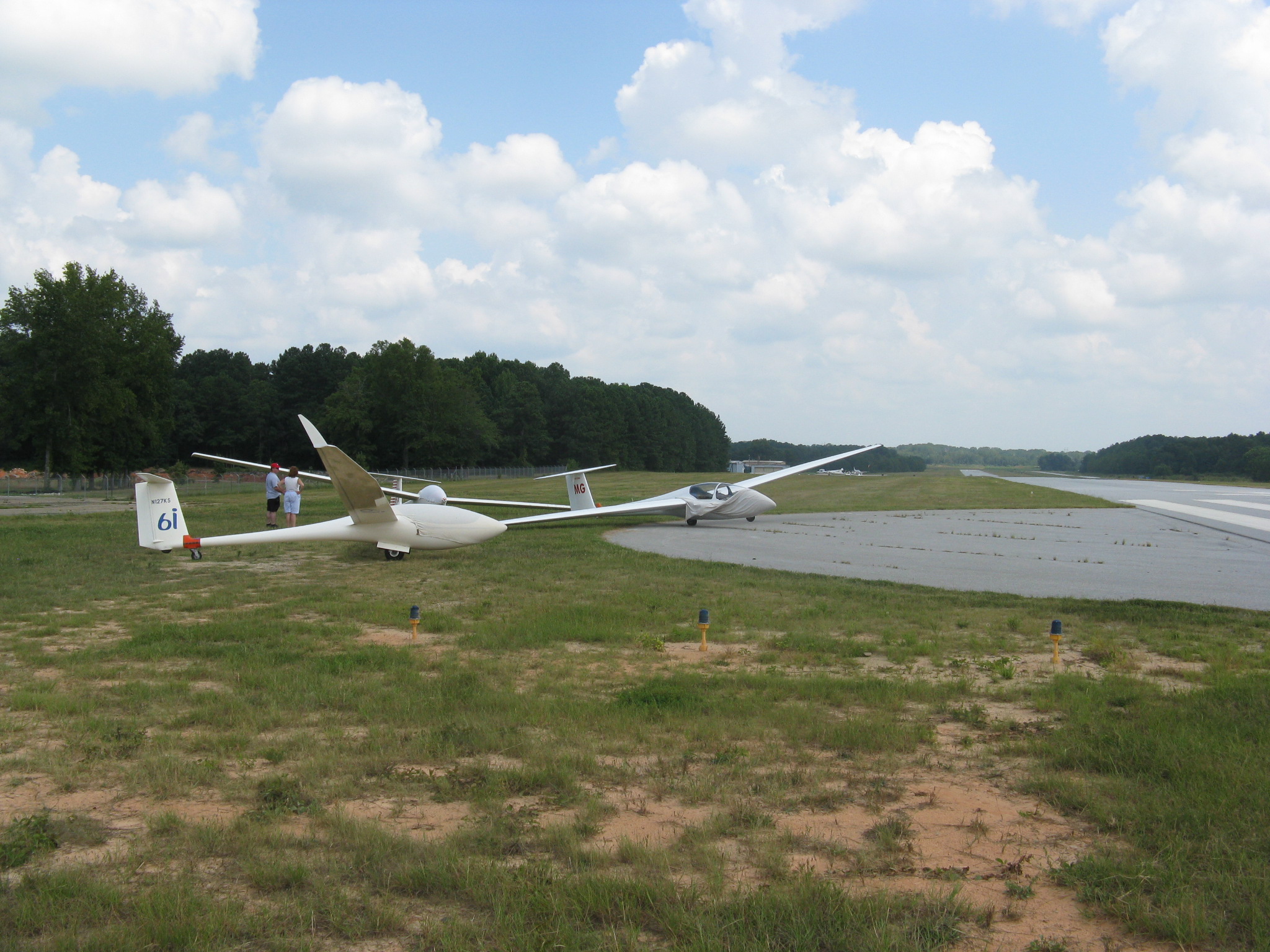 the glider guys assembled at their little place to the side of the airstrip, and the tow plane waiting on the other side. As gliders were ready to go, the tow plane would fire up, a tow cable would be latched onto the nose of the glider, and off they’d go.
the glider guys assembled at their little place to the side of the airstrip, and the tow plane waiting on the other side. As gliders were ready to go, the tow plane would fire up, a tow cable would be latched onto the nose of the glider, and off they’d go.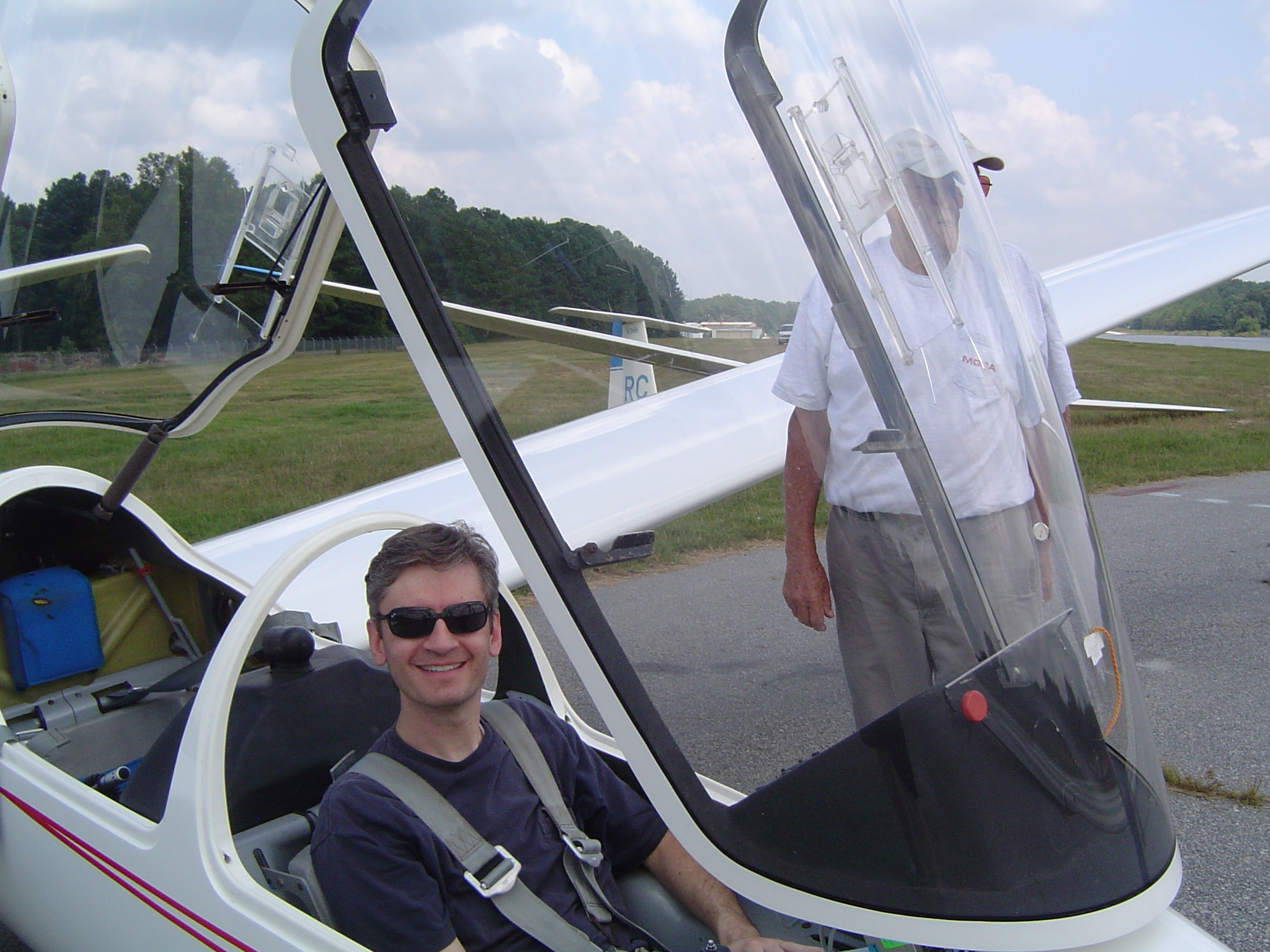 When we showed up at 11am, the guys were standing around looking at the sky and muttering about the low deck (around 2500 feet), but they expected it to rise as the day wore on, and it did.
When we showed up at 11am, the guys were standing around looking at the sky and muttering about the low deck (around 2500 feet), but they expected it to rise as the day wore on, and it did.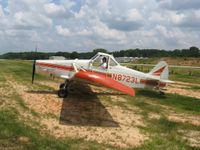 After some brief radio chatter, the tow plane fired up and pulled us down the runway and up into the air. We actually lifted off the ground well before the tow plane did, rising up a few feet before the tow plane had reached a speed where it could take off itself.
After some brief radio chatter, the tow plane fired up and pulled us down the runway and up into the air. We actually lifted off the ground well before the tow plane did, rising up a few feet before the tow plane had reached a speed where it could take off itself. They’re not particularly pretty to look at, but they get the job done. We slowly circled up into the sky, gaining altitude until we’d reached the cloud deck, at which point the glider pilot (sitting behind me) pulled the release on the tow cable and we were free.
They’re not particularly pretty to look at, but they get the job done. We slowly circled up into the sky, gaining altitude until we’d reached the cloud deck, at which point the glider pilot (sitting behind me) pulled the release on the tow cable and we were free.
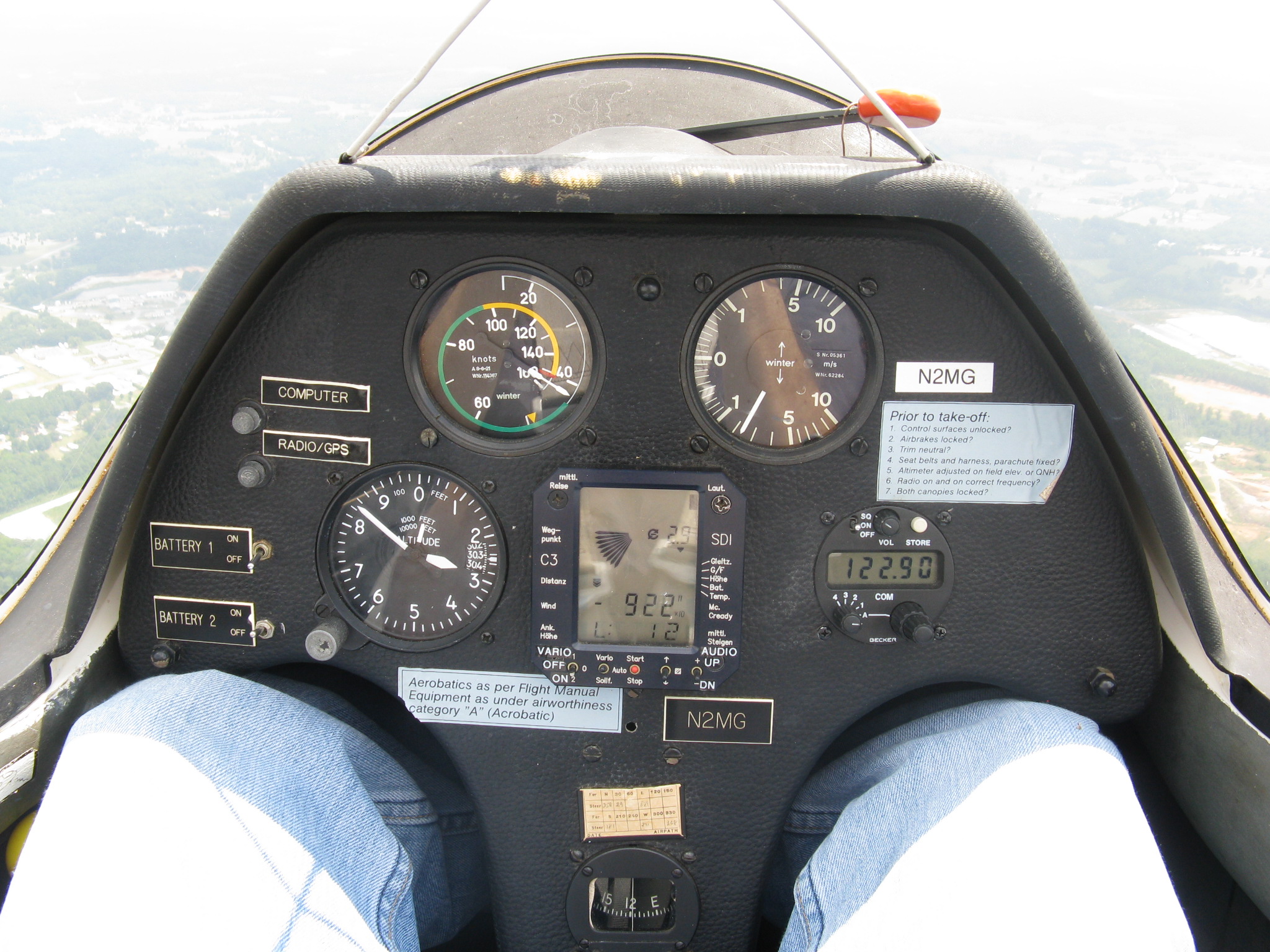 Apparently you can stay up forever this way, riding thermals indefinitely, until you run out of daylight. My ride was supposed to be only 30 minutes, but I guess that’s just a minimum that they promise you in case they don’t find any thermals, because we were up for nearly an hour. No, wait, I just checked the time stamps on the camera and I was up for 38 minutes!
Apparently you can stay up forever this way, riding thermals indefinitely, until you run out of daylight. My ride was supposed to be only 30 minutes, but I guess that’s just a minimum that they promise you in case they don’t find any thermals, because we were up for nearly an hour. No, wait, I just checked the time stamps on the camera and I was up for 38 minutes!  I thought it was quite a bit longer than that … I guess because after spiraling up the third or fourth thermal, my stomach was starting to get a little weary of it. Fortunately I didn’t commit the ultimate act of embarrassment, but I was glad to get back down on the ground.
I thought it was quite a bit longer than that … I guess because after spiraling up the third or fourth thermal, my stomach was starting to get a little weary of it. Fortunately I didn’t commit the ultimate act of embarrassment, but I was glad to get back down on the ground.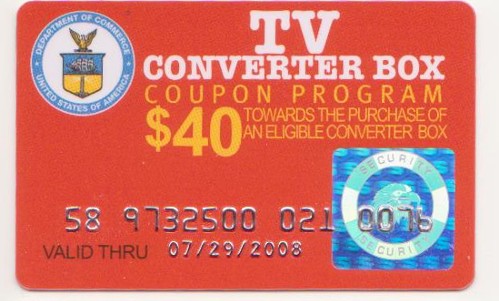 Step 1: Get your $40 DTV coupon. By act of Congress 3 years ago, every household in the country is entitled to two $40 coupons to pay for a little converter box. Don’t worry about what the box does (I’ll explain later). Don’t wonder if you really need it (you might, might not). Don’t worry about getting on some mailing list (you won’t). DO GET IT RIGHT NOW, because the deadline is approaching and there’s going to be a mad crush for them again. You may have heard about a June 12th deadline; well, if you wait until then, you’re too late. Go to
Step 1: Get your $40 DTV coupon. By act of Congress 3 years ago, every household in the country is entitled to two $40 coupons to pay for a little converter box. Don’t worry about what the box does (I’ll explain later). Don’t wonder if you really need it (you might, might not). Don’t worry about getting on some mailing list (you won’t). DO GET IT RIGHT NOW, because the deadline is approaching and there’s going to be a mad crush for them again. You may have heard about a June 12th deadline; well, if you wait until then, you’re too late. Go to  Step 3: Get a converter box. These are officially called “
Step 3: Get a converter box. These are officially called “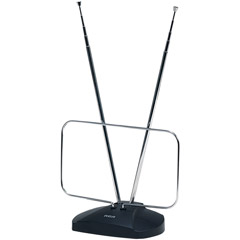 Step 4: Get an antenna. This is going to be the trickiest part, but hang in there. Most likely you will be able to get by with just a simple indoor antenna near your TV, like the old rabbit ears. But it’s not quite rabbit ears you need — those work best in VHF, and you need an antenna that works in UHF. The big metal loop part of most indoor antennas is what’s actually important for digital TV. So go to any electronics store and look for a small TV antenna.
Step 4: Get an antenna. This is going to be the trickiest part, but hang in there. Most likely you will be able to get by with just a simple indoor antenna near your TV, like the old rabbit ears. But it’s not quite rabbit ears you need — those work best in VHF, and you need an antenna that works in UHF. The big metal loop part of most indoor antennas is what’s actually important for digital TV. So go to any electronics store and look for a small TV antenna. 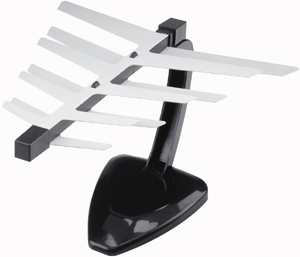 Don’t buy a big one yet — you probably won’t need it! A couple examples are the
Don’t buy a big one yet — you probably won’t need it! A couple examples are the  The Tesla Roadster is a slick, beautiful machine, and after 3+ years of salivating it is f i n a l l y reaching the streets. In the last few months they’ve finally started delivering units to their long-suffering customers, and they’re now up to about a 100 deliveries per month. With each unit getting them over $100K in revenue when they deliver, that’s going to very quickly get them in the black, and suddenly Detroit will have a real problem developing for them in sunny California.
The Tesla Roadster is a slick, beautiful machine, and after 3+ years of salivating it is f i n a l l y reaching the streets. In the last few months they’ve finally started delivering units to their long-suffering customers, and they’re now up to about a 100 deliveries per month. With each unit getting them over $100K in revenue when they deliver, that’s going to very quickly get them in the black, and suddenly Detroit will have a real problem developing for them in sunny California.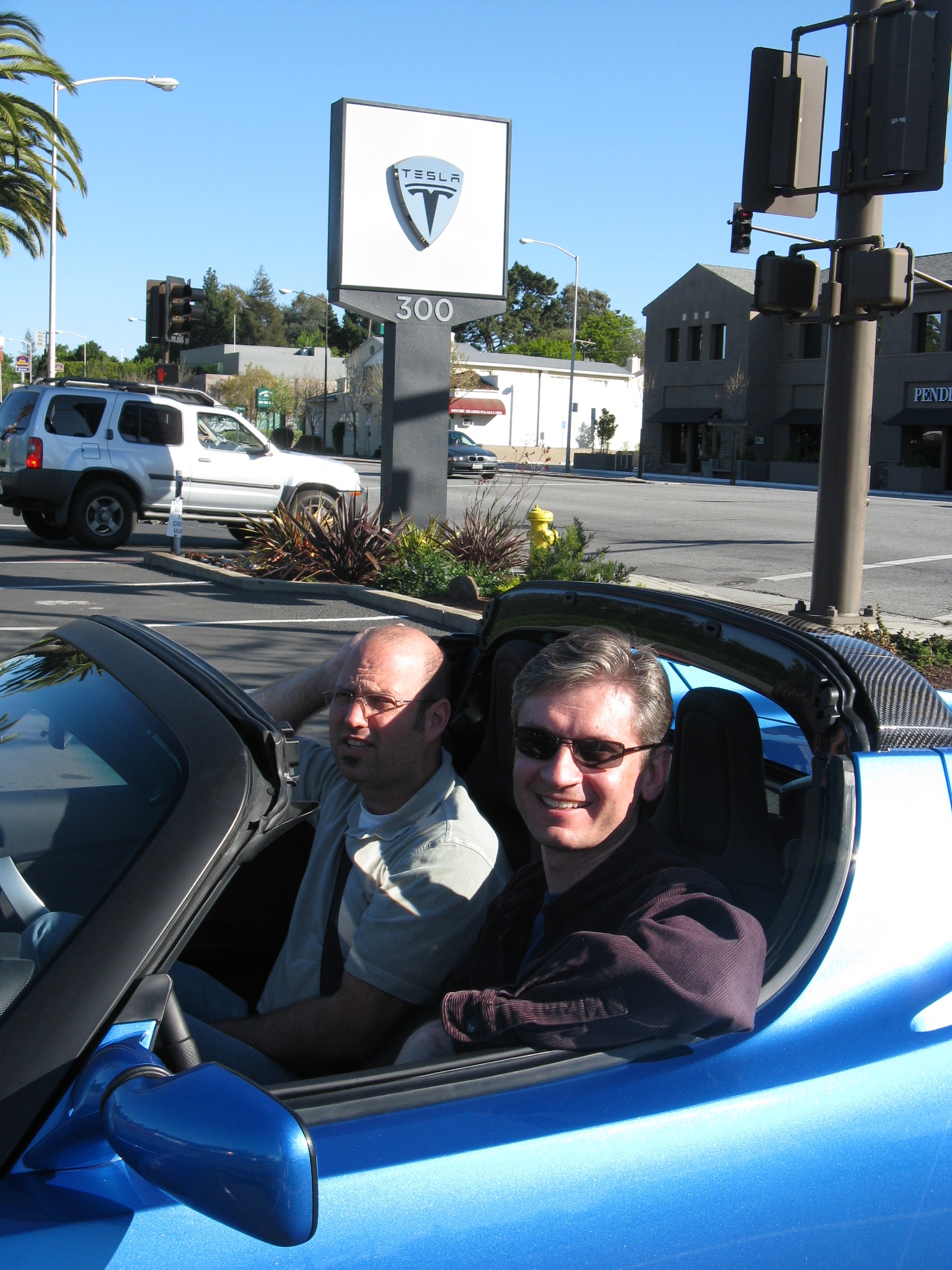 Earlier this month I visited family in the San Francisco area and I decided to try to get down to the Tesla dealership (in Menlo Park) to get a look in person. Actually I wanted to see the Model S (more on that below) but I knew they wouldn’t have any so I settled on just looking at a Roadster. Since they’ve finally cranked up the volume on production, they have more units to set aside for sales ops so there was a chance I’d be able to actually sit in one and maybe drive it around the block.
Earlier this month I visited family in the San Francisco area and I decided to try to get down to the Tesla dealership (in Menlo Park) to get a look in person. Actually I wanted to see the Model S (more on that below) but I knew they wouldn’t have any so I settled on just looking at a Roadster. Since they’ve finally cranked up the volume on production, they have more units to set aside for sales ops so there was a chance I’d be able to actually sit in one and maybe drive it around the block.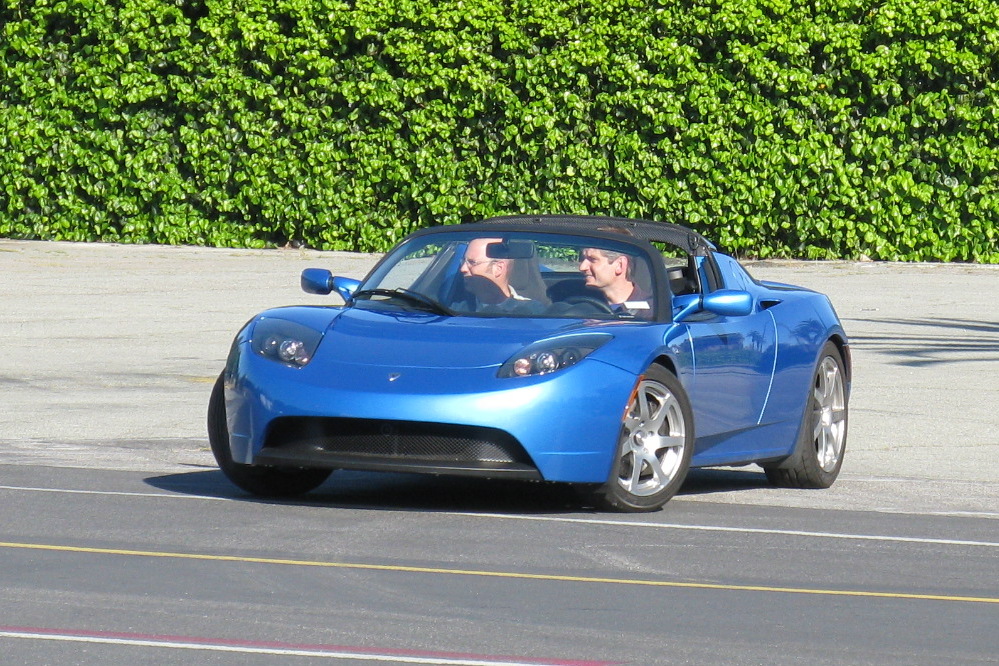 I quickly snagged my brother-in-law for passenger seat ballast (kidding!) and we got familiar with the vehicle. You can read all about it everywhere else, but it definitely is a pocket rocket. Bolting from 0 to 60 MPH in four seconds, it’s like acceleration isn’t an issue anymore — you just decide on a speed and BOOM you are there. One thing I had wondered was how annoying the braking feel woiuld be, since it uses regenerative braking for light to medium braking effort, and it was suprisingly unobtrusive. It just didn’t bug me. What was noticeable was the coasting behavioir, because they have it dialed in to brake slightly when you take your foot off the accelerator.
I quickly snagged my brother-in-law for passenger seat ballast (kidding!) and we got familiar with the vehicle. You can read all about it everywhere else, but it definitely is a pocket rocket. Bolting from 0 to 60 MPH in four seconds, it’s like acceleration isn’t an issue anymore — you just decide on a speed and BOOM you are there. One thing I had wondered was how annoying the braking feel woiuld be, since it uses regenerative braking for light to medium braking effort, and it was suprisingly unobtrusive. It just didn’t bug me. What was noticeable was the coasting behavioir, because they have it dialed in to brake slightly when you take your foot off the accelerator. Which Tesla will be happy to supply. On March 26th they announced their second design, the Model S. Instead of a tiny sports car, this will be a sports sedan that can carry 4-5 adults, basically competing with luxury sports sedans like the BMW 5-series. It’s also priced in that category at $57K, a number which will certainly get “refined” as they get closer to production. It got lots of attention:
Which Tesla will be happy to supply. On March 26th they announced their second design, the Model S. Instead of a tiny sports car, this will be a sports sedan that can carry 4-5 adults, basically competing with luxury sports sedans like the BMW 5-series. It’s also priced in that category at $57K, a number which will certainly get “refined” as they get closer to production. It got lots of attention: But what was unveiled was just a prototype — literally, there is ONE of these on the planet. Really what they are doing is getting the prototype out there so that the federal government will be unable to ignore it and will have to release some funds from the advanced car tech program that Congress approved last fall. I mean, if Tesla doesn’t qualify for this, I don’t know what does. Update 23-Jun-2009: Tesla has indeed today received the ATVM funding, all of the funding they requested! See press releases from
But what was unveiled was just a prototype — literally, there is ONE of these on the planet. Really what they are doing is getting the prototype out there so that the federal government will be unable to ignore it and will have to release some funds from the advanced car tech program that Congress approved last fall. I mean, if Tesla doesn’t qualify for this, I don’t know what does. Update 23-Jun-2009: Tesla has indeed today received the ATVM funding, all of the funding they requested! See press releases from  This past weekend the very first public charging station for Tesla opened up in Northern California. Here’s a
This past weekend the very first public charging station for Tesla opened up in Northern California. Here’s a  On the day before the scheduled launch, I went in to look around and check things out. After a few hours of lounging around the press building and getting lunch in the cafeteria, I set up the new telescope (which I’ll write about soon) at the edge of the turning basin. This first picture shows it with the large countdown clock in the field in the background, and the large silver boat is the covered barge that they used to transport the large orange fuel tank from the factory in New Orleans.
On the day before the scheduled launch, I went in to look around and check things out. After a few hours of lounging around the press building and getting lunch in the cafeteria, I set up the new telescope (which I’ll write about soon) at the edge of the turning basin. This first picture shows it with the large countdown clock in the field in the background, and the large silver boat is the covered barge that they used to transport the large orange fuel tank from the factory in New Orleans. At one point a bird fight erupted over the water. About a half-dozen ospreys were quite upset with a bald eagle. Eventually one of the ospreys got a good dig into the eagle’s back and he hauled ass out of there. I attempted to take pictures, but my camera only got one picture before declaring that it had weak batteries, oops it meant dead batteries, and quickly going dead. Thanks Canon! In this one picture, you can see the eagle at the left, turning hard just below the tree line, but you can’t see any ospreys (the bird on the buoy is just a heron or something watching the show).
At one point a bird fight erupted over the water. About a half-dozen ospreys were quite upset with a bald eagle. Eventually one of the ospreys got a good dig into the eagle’s back and he hauled ass out of there. I attempted to take pictures, but my camera only got one picture before declaring that it had weak batteries, oops it meant dead batteries, and quickly going dead. Thanks Canon! In this one picture, you can see the eagle at the left, turning hard just below the tree line, but you can’t see any ospreys (the bird on the buoy is just a heron or something watching the show).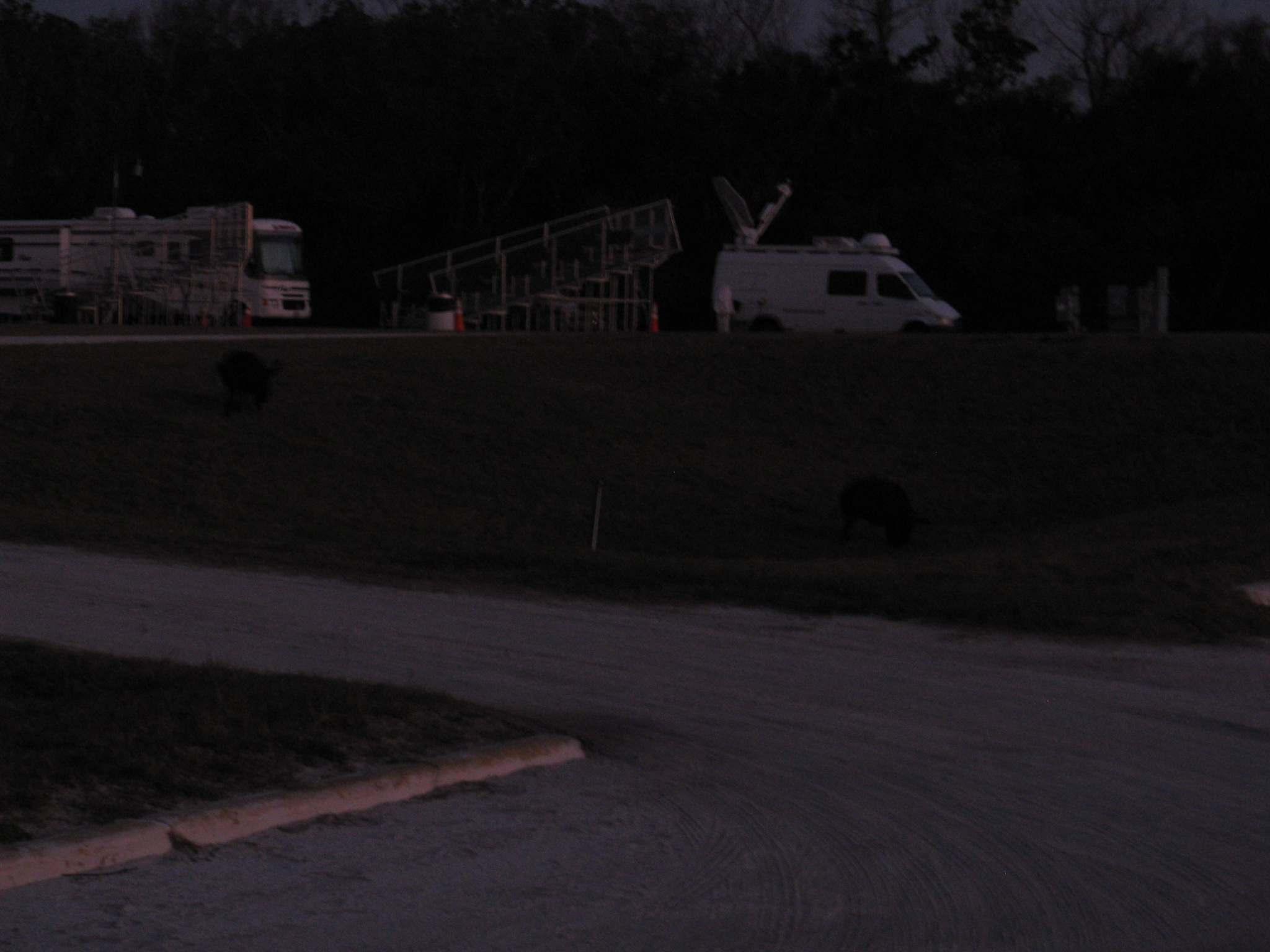 As dusk fell, feral pigs came out of the brush to sniff around on the grass. One of the reporters here said he’s seen bobcats, and once almost stepped on a rattlesnake.
As dusk fell, feral pigs came out of the brush to sniff around on the grass. One of the reporters here said he’s seen bobcats, and once almost stepped on a rattlesnake.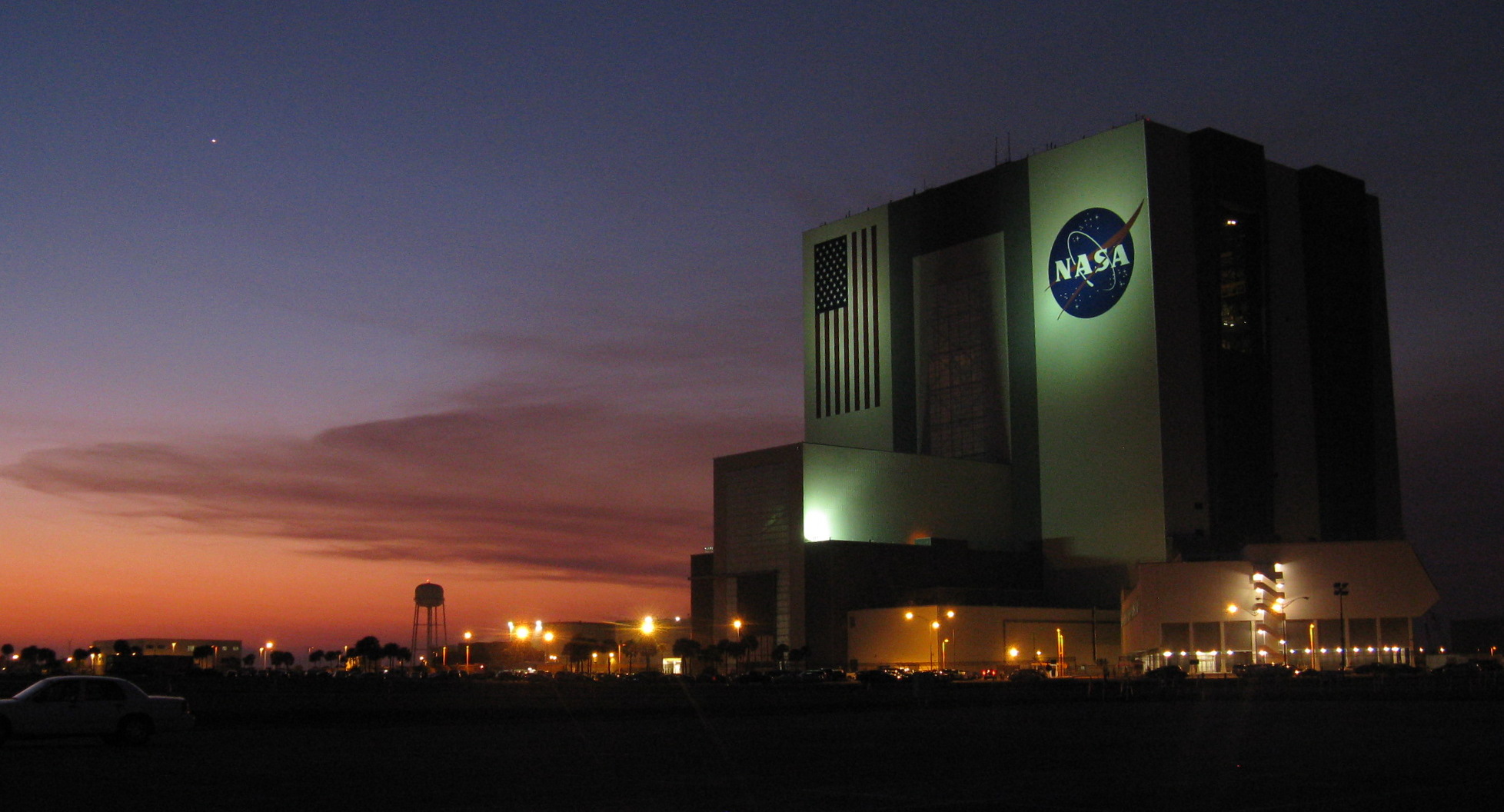 On Wednesday, I arrived at midday ready for a long day of countdown and launch monitoring. However at around 2:30pm (well into the countdown but still 7 hours to go) the scrubbed due to a fuel leak. After moping around the press site for a while I pulled out of there and went to dinner with some work folks. As of right now the word is that they will try again on Sunday. I was planning on driving back home on Saturday, but I’m going to tough it out and stay until this launches. Yes, extending my vacation in Florida, it’s rough!
On Wednesday, I arrived at midday ready for a long day of countdown and launch monitoring. However at around 2:30pm (well into the countdown but still 7 hours to go) the scrubbed due to a fuel leak. After moping around the press site for a while I pulled out of there and went to dinner with some work folks. As of right now the word is that they will try again on Sunday. I was planning on driving back home on Saturday, but I’m going to tough it out and stay until this launches. Yes, extending my vacation in Florida, it’s rough! Struggle with decisions like A) go to beach, B) get lunch or C) read book.
Struggle with decisions like A) go to beach, B) get lunch or C) read book.
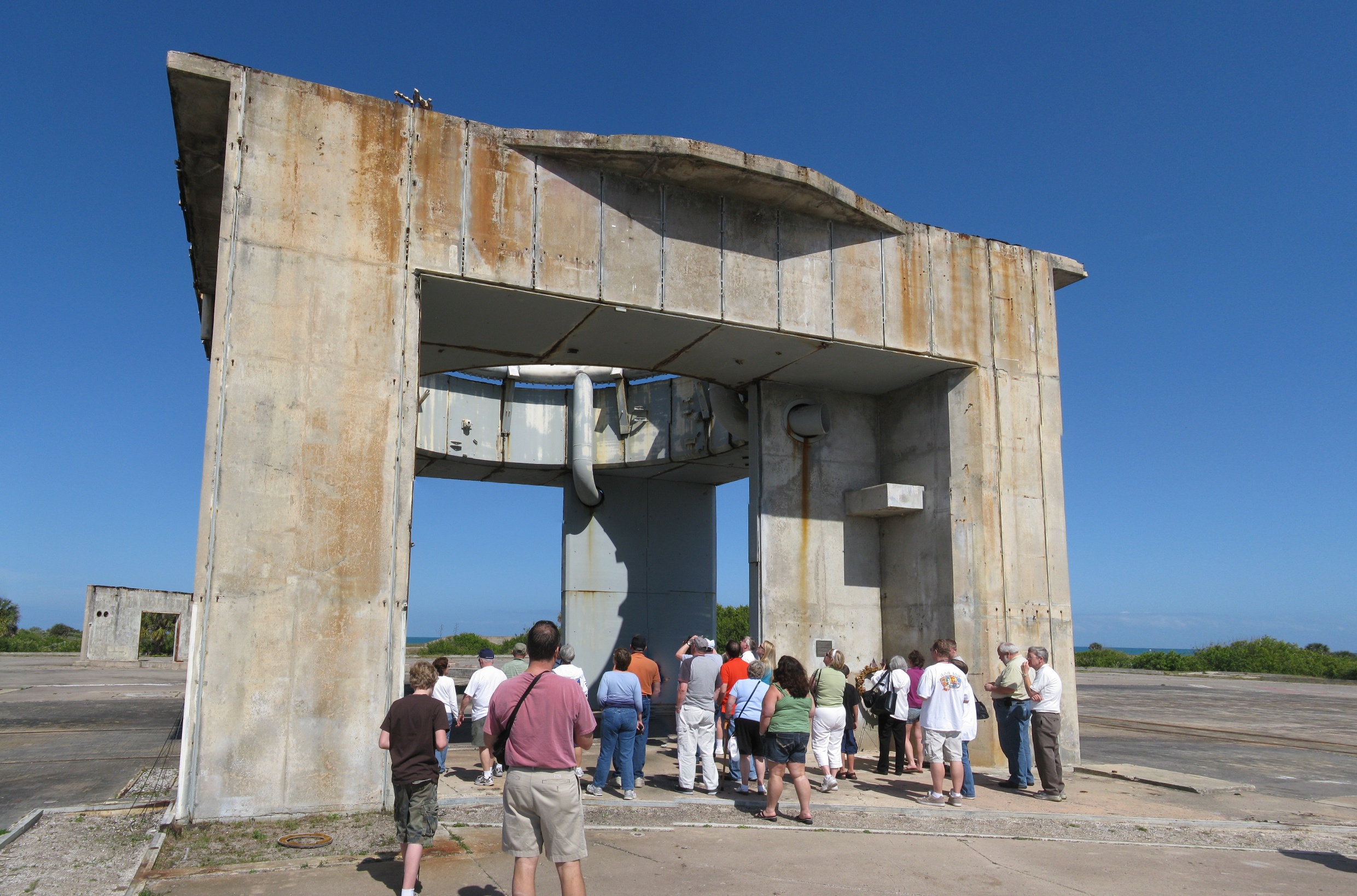 Go on the “Now and Then” bus tour of the old Cape Canaveral launch pads. Ending up at the Saturn V site, which by the end of the day was largely empty, allowing me to get a nice quiet look at the business end.
Go on the “Now and Then” bus tour of the old Cape Canaveral launch pads. Ending up at the Saturn V site, which by the end of the day was largely empty, allowing me to get a nice quiet look at the business end.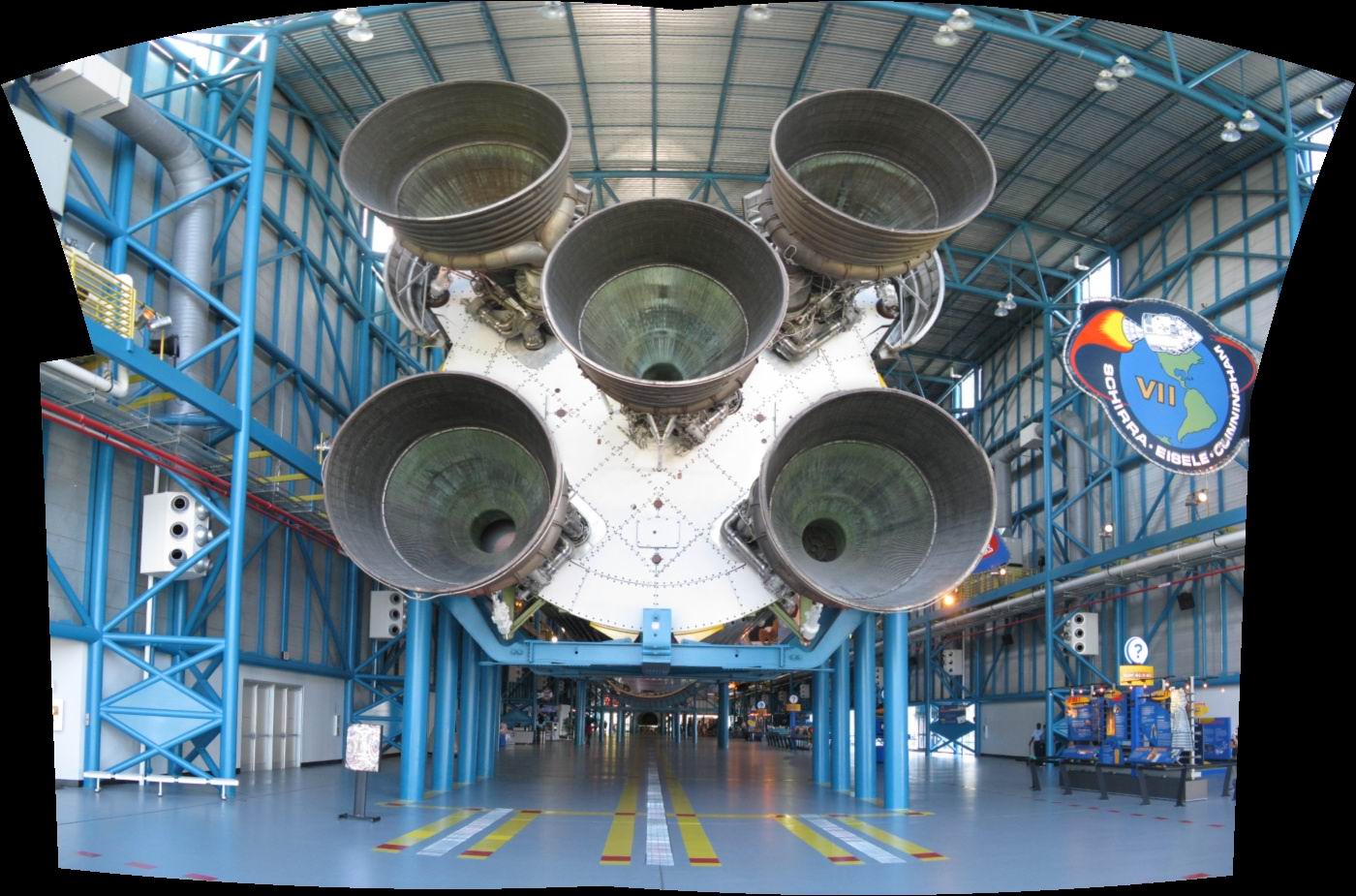

 Reminded once again of how, during the Dec 2007 trip, I completely forgot about the Atlas launch happening then (after the shuttle scrubbed) and it launched as we were sitting in a theater taking in a movie.
Reminded once again of how, during the Dec 2007 trip, I completely forgot about the Atlas launch happening then (after the shuttle scrubbed) and it launched as we were sitting in a theater taking in a movie.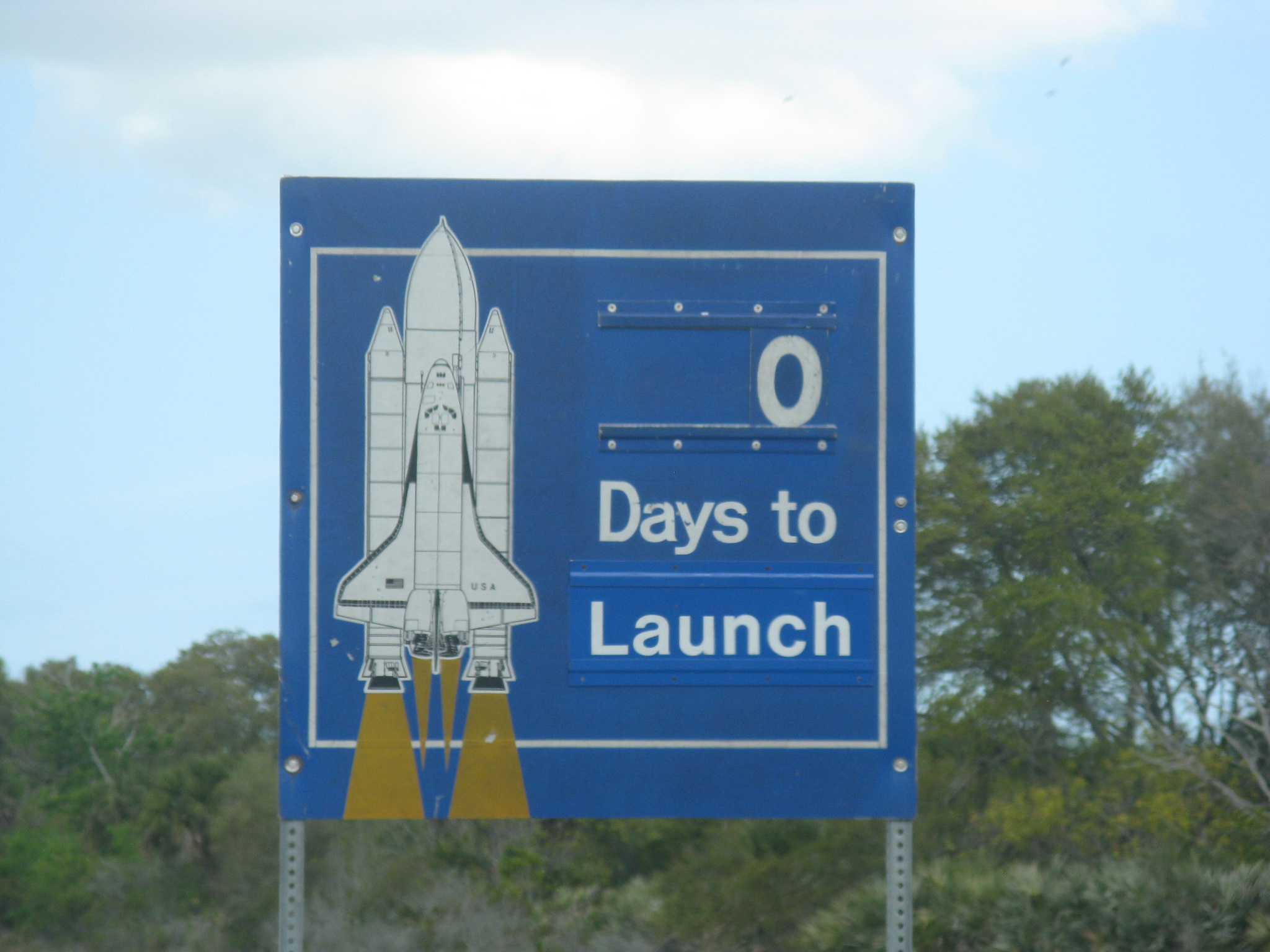 Sunday March 15th. Tanking took place between 10am and 1pm; by 1:30pm we knew they’d gotten past the problem that caused the scrub last Wednesday.
Sunday March 15th. Tanking took place between 10am and 1pm; by 1:30pm we knew they’d gotten past the problem that caused the scrub last Wednesday.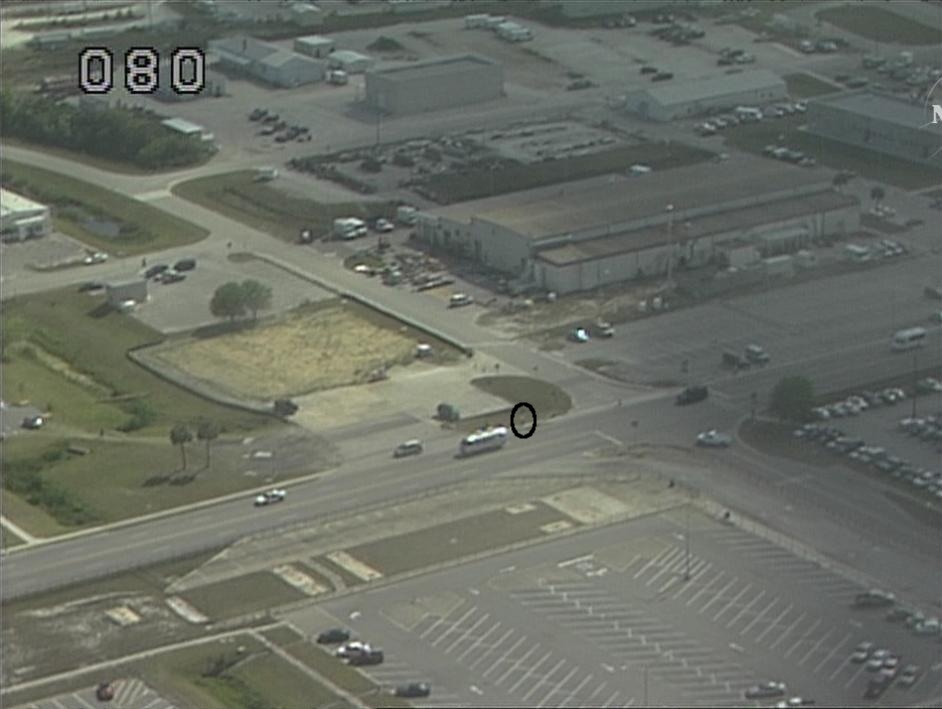 1. Astrovan driving past the VAB, with me on the sidewalk waving at it (circled in photo, click to enlarge). I knew that they would stop around there some place to drop someone off, so I was ready to take pictures and wave at astronauts. Unfortunately, I was standing in the wrong place and the convoy flew right by me!
1. Astrovan driving past the VAB, with me on the sidewalk waving at it (circled in photo, click to enlarge). I knew that they would stop around there some place to drop someone off, so I was ready to take pictures and wave at astronauts. Unfortunately, I was standing in the wrong place and the convoy flew right by me!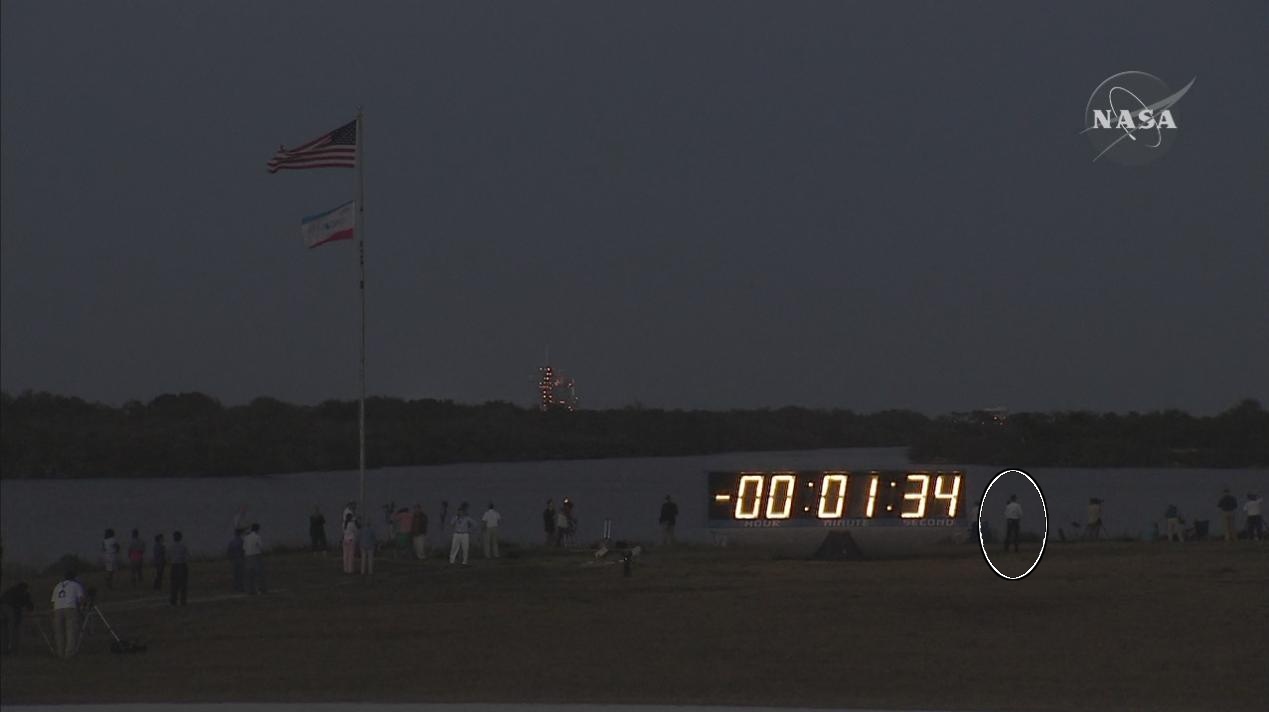 2. View from the press site just before launch, with me standing to the right of the countdown clock. There was a staffer shooing people away from in front of the clock. About 10 feet in front of me was the water’s edge, and that’s where most people were standing and setting up their camera tripods (news photographers).
2. View from the press site just before launch, with me standing to the right of the countdown clock. There was a staffer shooing people away from in front of the clock. About 10 feet in front of me was the water’s edge, and that’s where most people were standing and setting up their camera tripods (news photographers).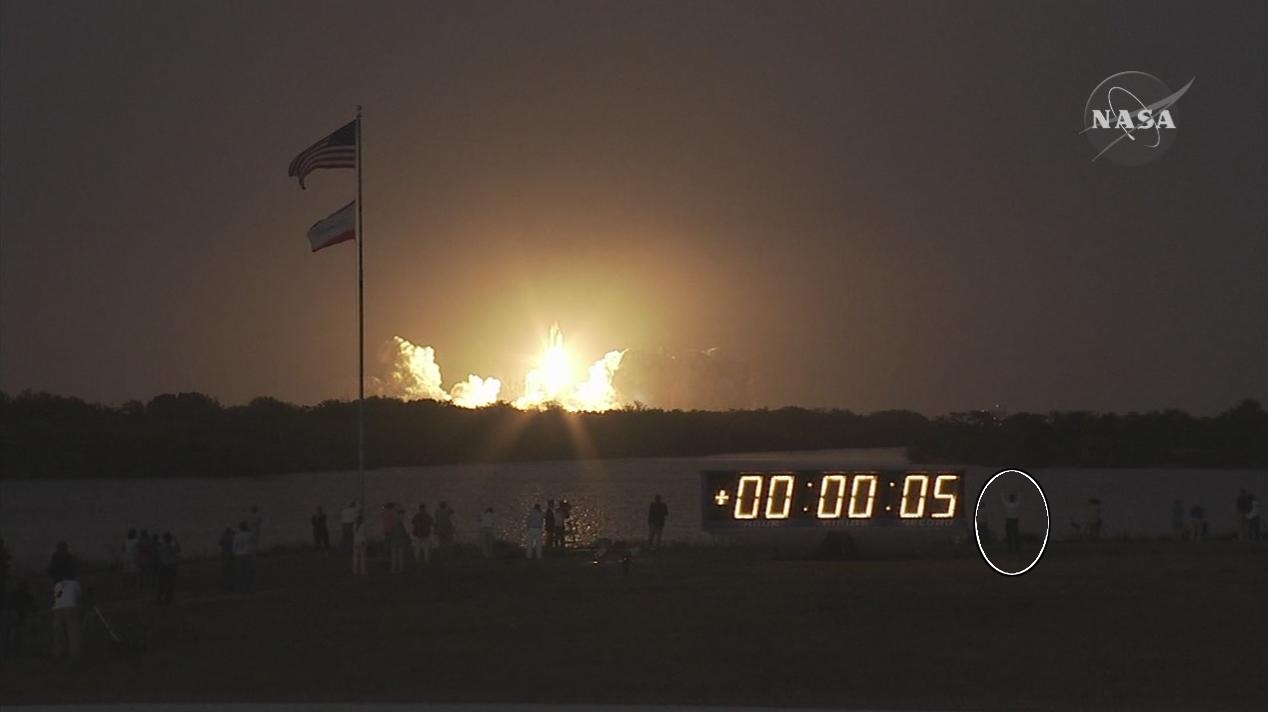 3. View from the press site seconds after launch, with me throwing my arms in the air. 20+ years!
3. View from the press site seconds after launch, with me throwing my arms in the air. 20+ years!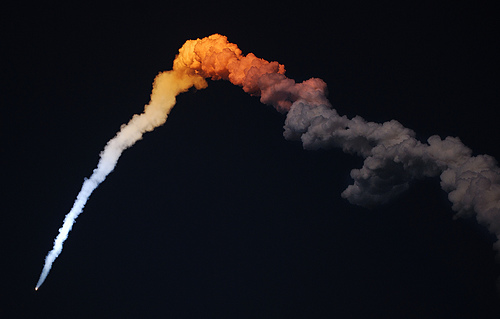 Here’s what two of the rock stars of NASA said at the press briefing after the launch (which I snuck into):
Here’s what two of the rock stars of NASA said at the press briefing after the launch (which I snuck into):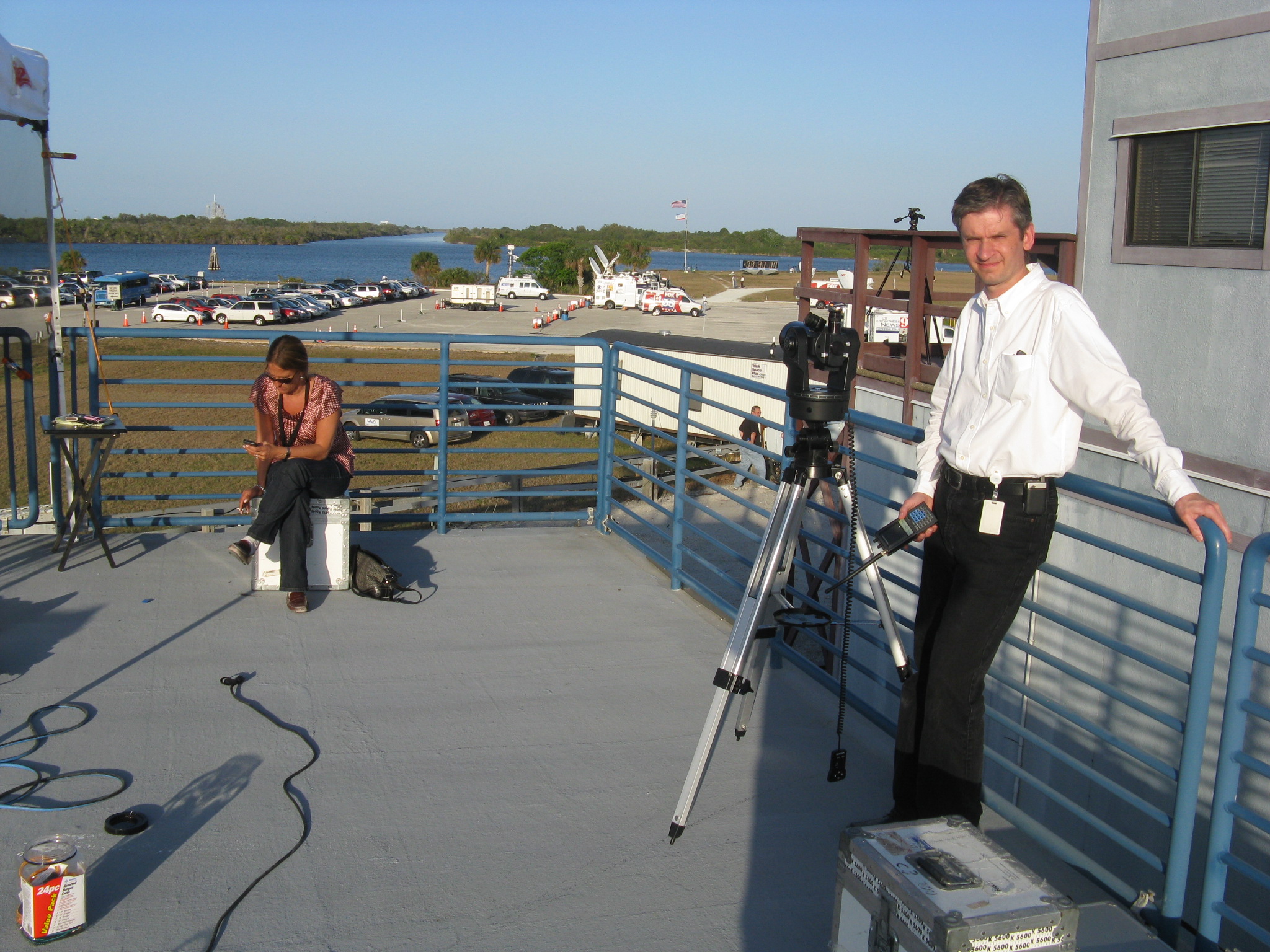 It’s sad that there’s only 8 more of these left, maybe 9 or 10 if they throw money at NASA to extend the shuttle program a little bit more. It’s a beautiful thing to see on the pad and provided us with such gorgeous launches. In 2015 we should start to see
It’s sad that there’s only 8 more of these left, maybe 9 or 10 if they throw money at NASA to extend the shuttle program a little bit more. It’s a beautiful thing to see on the pad and provided us with such gorgeous launches. In 2015 we should start to see  Turns out that they were part of a group called the
Turns out that they were part of a group called the  Note the fancy bearing made of plywood, although I’ll admit that there’s a couple small pieces of teflon in there (that was a later upgrade, actually). See the secondary mirror suspended in the top end of the tube — I think those three legs are made of paint stirring sticks.
Note the fancy bearing made of plywood, although I’ll admit that there’s a couple small pieces of teflon in there (that was a later upgrade, actually). See the secondary mirror suspended in the top end of the tube — I think those three legs are made of paint stirring sticks. 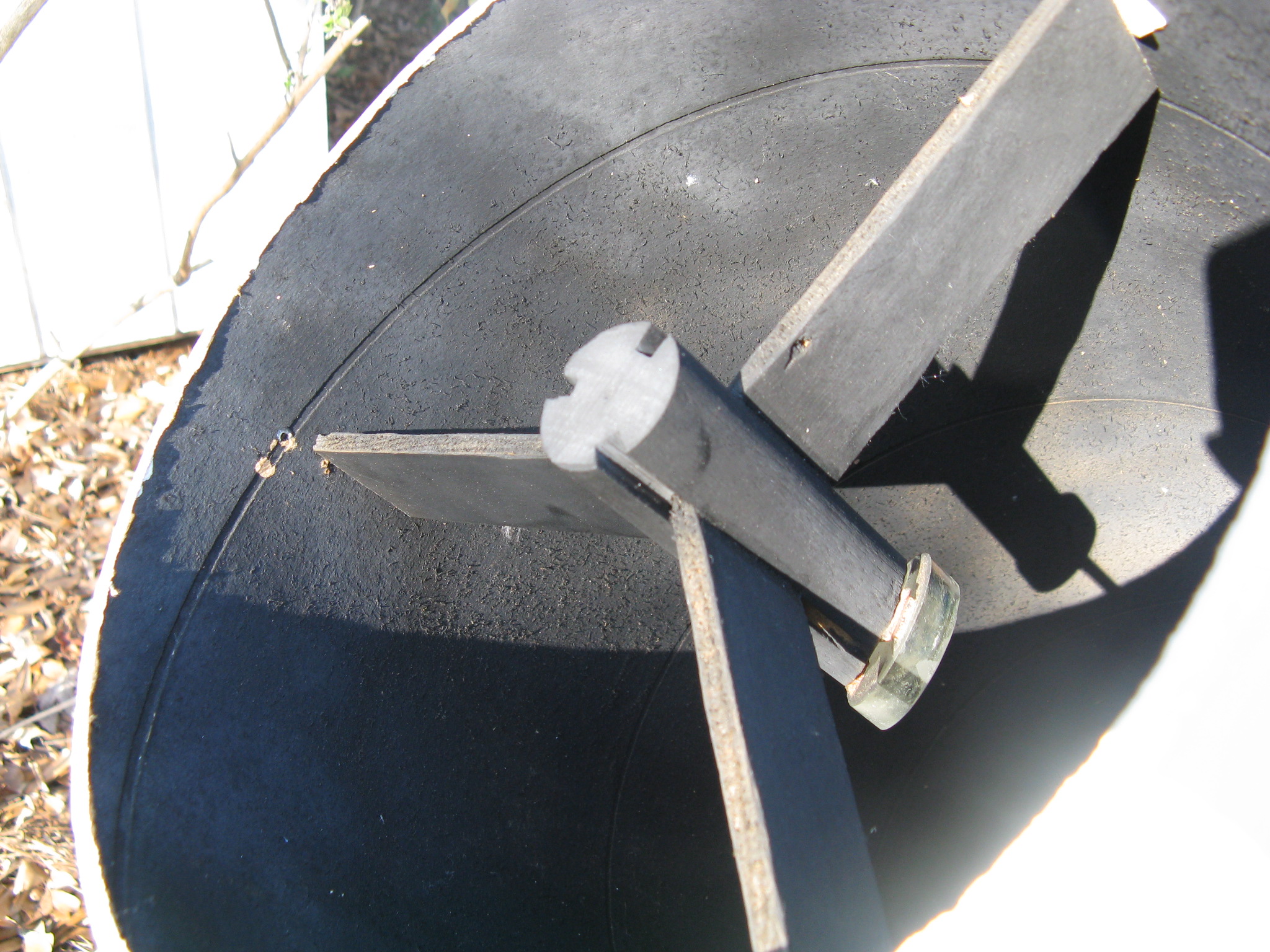 It certainly looked pretty good after I got around to painting it. And note the bungie cord holding the mirror in place! The big
It certainly looked pretty good after I got around to painting it. And note the bungie cord holding the mirror in place! The big 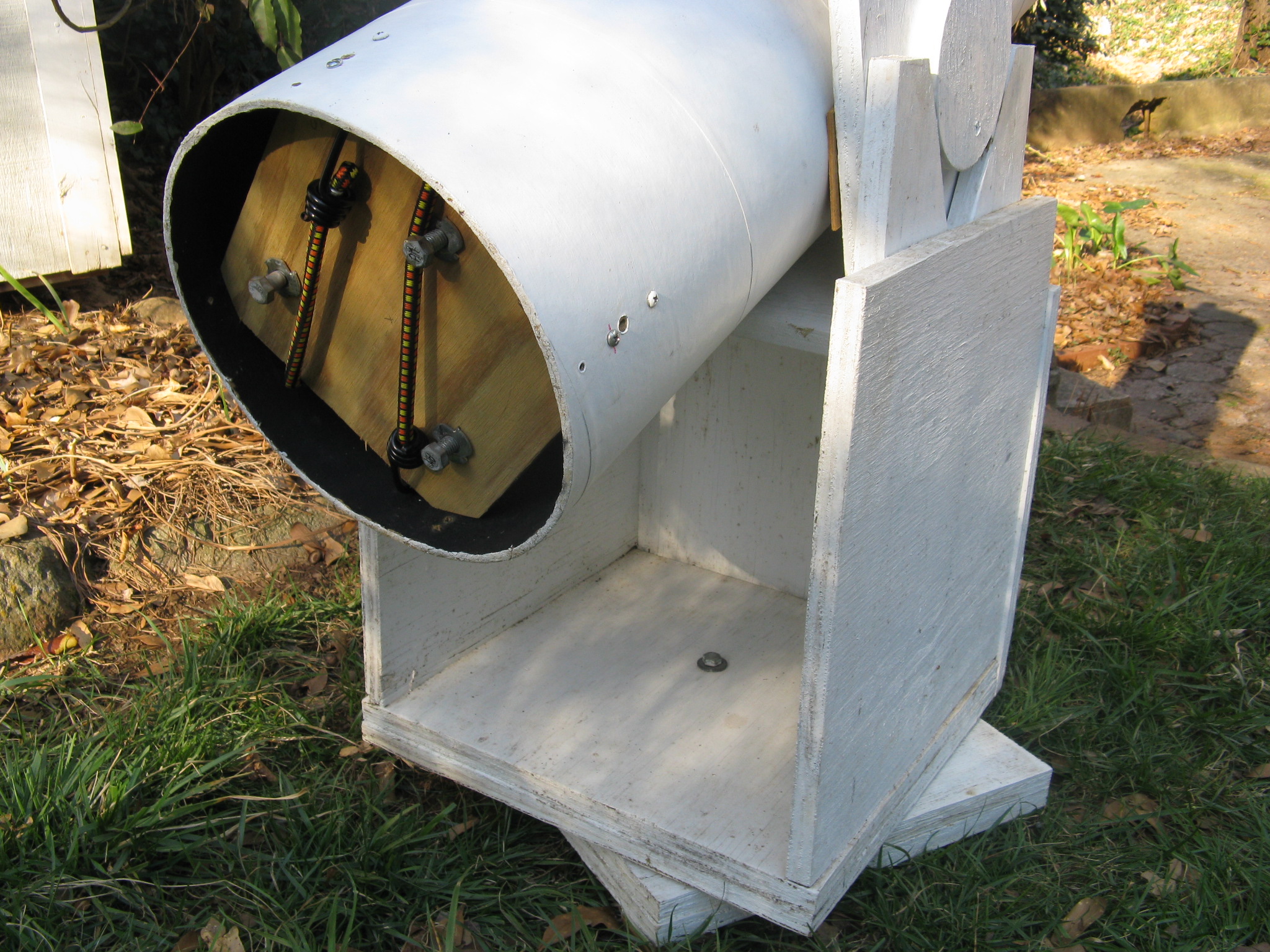 The bungie cord simply keeps the mirror from flopping forward, and doesn’t really degrade the image so I just left it there.
The bungie cord simply keeps the mirror from flopping forward, and doesn’t really degrade the image so I just left it there.